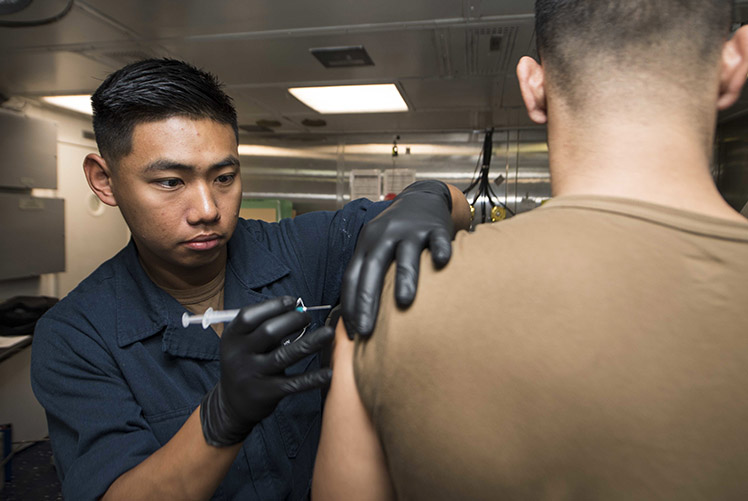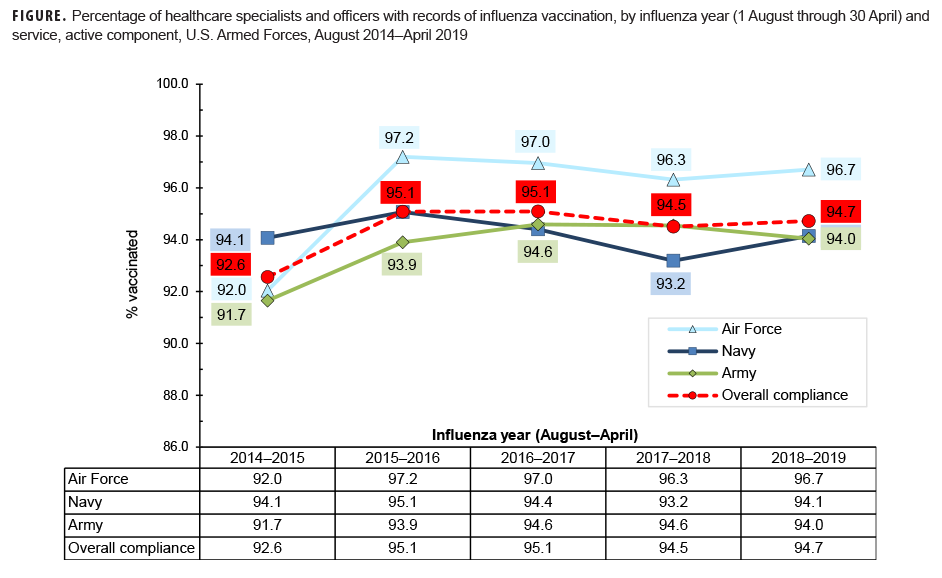Surveillance Snapshot: Influenza Immunization Among U.S. Armed Forces Healthcare Workers, Aug. 2014–April 2019
 181129-N-GR847-3000
ARABIAN GULF (Nov. 29, 2018) Hospitalman Jay Meadows, from Weaver, Ala., administers an influenza vaccine to a Sailor during a regularly scheduled deployment of the Essex Amphibious Ready Group (ARG) and 13th Marine Expeditionary Unit (MEU). The Essex ARG/13th MEU is flexible and persistent Navy-Marine Corps team deployed to the U.S. 5th Fleet area of operations in support of naval operations to ensure maritime stability and security in the Central Region, connecting to the Mediterranean and the Pacific through the western Indian Ocean and three strategic choke points. (U.S. Navy photo by Mass Communication Specialist 3rd Class Reymundo A. Villegas III)
181129-N-GR847-3000
ARABIAN GULF (Nov. 29, 2018) Hospitalman Jay Meadows, from Weaver, Ala., administers an influenza vaccine to a Sailor during a regularly scheduled deployment of the Essex Amphibious Ready Group (ARG) and 13th Marine Expeditionary Unit (MEU). The Essex ARG/13th MEU is flexible and persistent Navy-Marine Corps team deployed to the U.S. 5th Fleet area of operations in support of naval operations to ensure maritime stability and security in the Central Region, connecting to the Mediterranean and the Pacific through the western Indian Ocean and three strategic choke points. (U.S. Navy photo by Mass Communication Specialist 3rd Class Reymundo A. Villegas III)
The U.S. Advisory Committee on Immunization Practices recommends that all health care personnel be vaccinated against influenza to protect themselves and their patients.1 The Joint Commission's standard on infection control emphasizes that individuals who are infected with influenza virus are contagious to others before any signs or symptoms appear. The Joint Commission requires that health care organizations have influenza vaccination programs for practitioners and staff and that they work toward the goal of 90% receipt of influenza vaccine. Within the Department of Defense, seasonal influenza immunization is mandatory for all uniformed personnel and for health care personnel who provide direct patient care and is recommended for all others (excluding those who are medically exempt).2–4
This snapshot covers a 5-year surveillance period (Aug. 2014–April 2019) and presents the documented percentage compliance with the influenza immunization requirement among active component health care personnel of the Army, Navy, and Air Force. During the 2018–2019 influenza season, each of the 3 services had compliance rates of 94.0% or higher among health care personnel (Figure). For all services together, the compliance rate was 94.7%, very similar to the rate from the previous year.
References
- Centers for Disease Control and Prevention. Immunization of health-care personnel: recommendations of the Advisory Committee on Immunization Practices (ACIP). MMWR Recomm Rep. 2011;60(RR-7):1–45.
- Headquarters, Departments of the Army, the Navy, the Air Force, and the Coast Guard. Army Regulation 40-562, BUMEDINST 6230.15B, AFI 48-110_IP, CG COMDTINST M6230.4G. Medical Services: Immunizations and Chemoprophylaxis for the Prevention of Infectious Diseases. 7 Oct. 2013.
- Assistant Secretary of Defense for Health Affairs. Policy for Mandatory Seasonal Influenza Immunization for Civilian Health Care Personnel Who Provide Direct Patient Care in Department of Defense Military Treatment Facilities. Health Affairs Policy 08-005. 4 April 2008.
- Assistant Secretary of Defense for Health Affairs. Addition of Pandemic Influenza Vaccine or Novel Influenza Vaccine to the Policy for Mandatory Seasonal Influenza Immunization for Civilian Health Care Personnel Who Provide Direct Patient Care in Department of Defense Military Treatment Facilities. Health Affairs Policy 11-010. 28 July 2011.

You also may be interested in...
Fact Sheet
Mar 30, 2017
 .PDF |
283.00 KB
.PDF |
283.00 KB
This fact sheet provides details on the demographic and military traits of service members diagnosed as traumatic brain injury (TBI) cases during a 16-year surveillance period from 2001 through 2016, a total of 276,858 active component service members received first-time diagnoses of TBI - a structural alteration of the brain or physiological ...
Fact Sheet
Mar 30, 2017
 .PDF |
267.04 KB
.PDF |
267.04 KB
This fact sheet provides details on heat illnesses by location during a five-year surveillance period from 2012 through 2016. 11,967 heat-related illnesses were diagnosed at more than 250 military installations and geographic locations worldwide. Three Army Installations accounted for close to one-third of all heat illnesses during the period.
Fact Sheet
Mar 30, 2017
 .PDF |
313.80 KB
.PDF |
313.80 KB
This fact sheet provides details on Rhabdomyolysis by location for active component, U.S. Armed Forces during a five-year surveillance period from 2012 through 2016. The medical treatment facilities at nine installations diagnosed at least 50 cases each and, together approximately half (49.9%) of all diagnosed cases.
You are leaving Health.mil
The appearance of hyperlinks does not constitute endorsement by the Department of Defense of non-U.S. Government sites or the information, products, or services contained therein. Although the Defense Health Agency may or may not use these sites as additional distribution channels for Department of Defense information, it does not exercise editorial control over all of the information that you may find at these locations. Such links are provided consistent with the stated purpose of this website.
You are leaving Health.mil
View the external links disclaimer.
Last Updated: July 11, 2023